Active Galactic Nuclei and their Host Galaxies
Overview
Supermassive black holes (SMBH) are now believed to be present in the centers of most, if not all, large galaxies. During growth phases, SMBH are observed as active galactic nuclei (AGN); the SMBH grows by accreting interstellar gas while releasing vast amounts of energy in the form of electromagnetic radiation, high speed gas outflows and jets of plasma ejected at relativistic speeds. This energy release is thought to have a major impact on galaxy evolution, clearing away or superheating gas that would otherwise form stars.
The most luminous AGN (known as quasars) are thought to be triggered during mergers between gas-rich spiral galaxies. Gravitational tides generated by the merger drive gas into the galaxy core(s), causing intense star-formation and also fueling the SMBH. Theory predicts that a galaxy merger also results in the formation of an SMBH binary (a bound pair of SMBH orbiting their center of mass) at the center of the merged galaxy. The SMBH binary will itself eventually coalesce with an enormous outburst of gravitational waves and electromagnetic radiation.
The RIT AGN-Galactic Environments research group studies several aspects of AGN and the interplay between SMBHs and their host galaxies using a combination of targeted multiwavelength observations with space and ground-based telescopes as well as computer simulations. Current projects include:
Reverberation Mapping the Circumnuclear Dusty Torus in AGN
Active SMBH are surrounded by dusty molecular gas, which is roughly in the form of a torus and causes severe obscuration from soft X-ray to near-infrared wavelengths. As the dust absorbs UV/optical radiation from the accretion disk around the SMBH and re-emits in the infrared (IR), variations in the AGN’s UV/optical luminosity produce a corresponding response in the dust IR emission. The IR response is modulated by light travel delays, causing a “light echo”, which contains information on the size and structure of the torus as well as the physical properties of the emitting dust. In this project we are analyzing infrared “light echo” data obtained with the Spitzer Space Telescope for a sample of AGN in order to determine the size of the dusty torus. We have also developed a computer simulation of the reverberation response of the dust emission, which is being used to model the data in order to better understand the overall torus structure and the properties of the dust distributed within it.
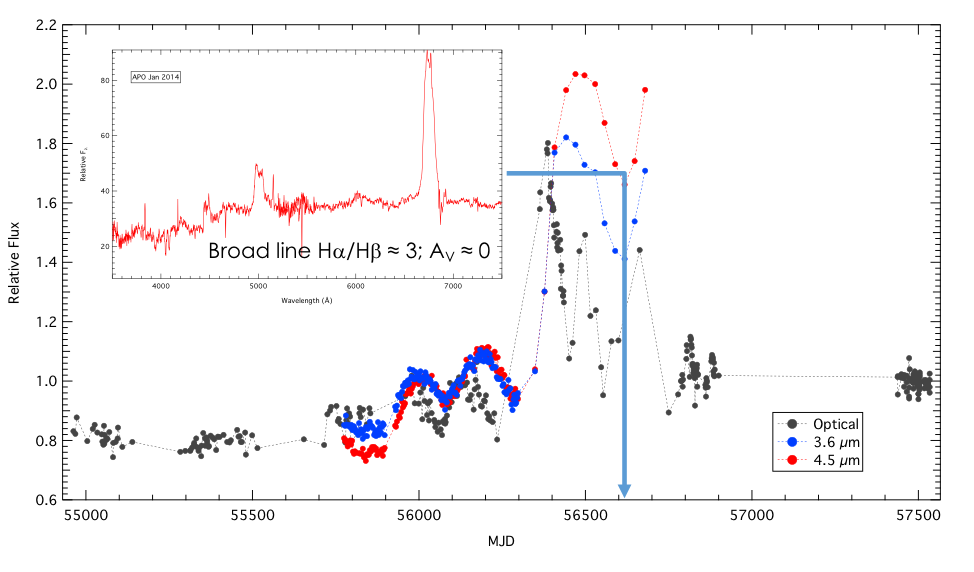
Optical and Spitzer IR light curves of the Seyfert galaxy NGC6418. A strong flare was observed in this object, which was accompanied by a dramatic increase in the strengths of the broad emission lines (inset). Following the flare, the optical–IR lag increased, implying a corresponding increase in the torus inner radius (Vazquez et al. 2015 ApJ, 801, 127; Robinson et al. 2019, in preparation).
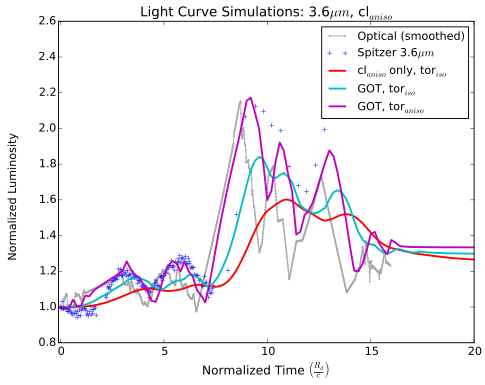
Simulated 3.6 µm light curves computed with our dust reverberation mapping code, TORMAC, using the interpolated observed optical light curve of NGC 6418 (grey solid line) as the input. Also plotted is the observed 3.6 µm light curve. (Almeyda et al. 2017, ApJ, 843, 3; 2017; Almeyda 2017, Ph,D. Dissertation, RIT.)
Probing Gas Flows Around Supermassive Black Holes with Spectropolarimetry
AGN spectra are characterized by strong and very broad emission lines which originate from ionized gas in close proximity to the SMBH. These lines provide important diagnostics of the physical processes operating in the vicinity of the SMBH and can also be used to measure the mass of the SMBH itself. In this project, we are studying the structure and dynamics of these gas flows by analysing and modelling measurements of the polarization of the optical emission lines and continuum in large samples of AGN covering wide ranges in inferred SMBH mass and accretion rate. The unique power of this method is that the polarization state of scattered light from the AGN carries the imprint of the scattering geometry, allowing the structure and kinematics of both scattering and emitting material to be investigated in the unresolved and partially obscured nucleus. We have obtained spectropolarimetry observations of approximately 100 broad-line AGN (the largest such sample yet assembled) and are currently completing our analysis of this data set. We have identified one of these AGN as a system in which the SMBH may be undergoing gravitational recoil.
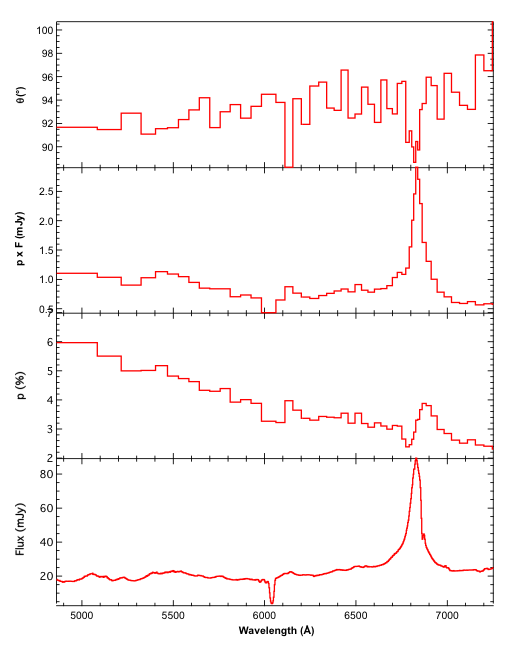
Optical polarization spectrum of the Seyfert galaxy Mrk 231. From top to bottom: polarization position angle, polarized flux, percentage polarization, total flux. The polarization variations across the broad Ha profile indicate equatorial scattering as well as a polar scattering outflow (Smith et al. 2004 350, 140).
Searches for Recoiling Supermassive Black Holes
When two galaxies merge, their SMBHs form a binary system at the center of the merged system, which eventually coalescences due to the energy lost in the form of gravitational waves. General Relativity predicts that the gravitational wave emission is strongly anisotropic for certain orbital configurations, which causes the merged SMBH to recoil with a large velocity, up to several 1000 km/s. The recoiling SMBH subsequently undergoes long-lived (~1 Gyr) oscillations in the host galaxy and while it is actively accreting, it can be observed as an AGN that is offset from the center of its galaxy. The predicted offset AGN provide electromagnetic “signposts” of binary SMBH coalescence events, which although they are extremely luminous gravitational wave sources, cannot be detected by current gravitational wave detectors. We are searching for gravitationally recoiling SMBH both by measuring spatial displacements between the AGN and the center of its host galaxy and by measuring doppler shifts between the AGN emission lines and the host galaxy. In an analysis of Hubble Space Telescope images of a large sample of active elliptical galaxies, we have identified about a dozen cases in which the AGN is displaced, possibly as a result of residual gravitational recoil oscillations. In addition, we previously identified the quasar E1821+643 as a recoil candidate from doppler shifts in its polarized light. To confirm this, we are looking for the expected spatial offset using a combination of spectroastrometry and HST images.
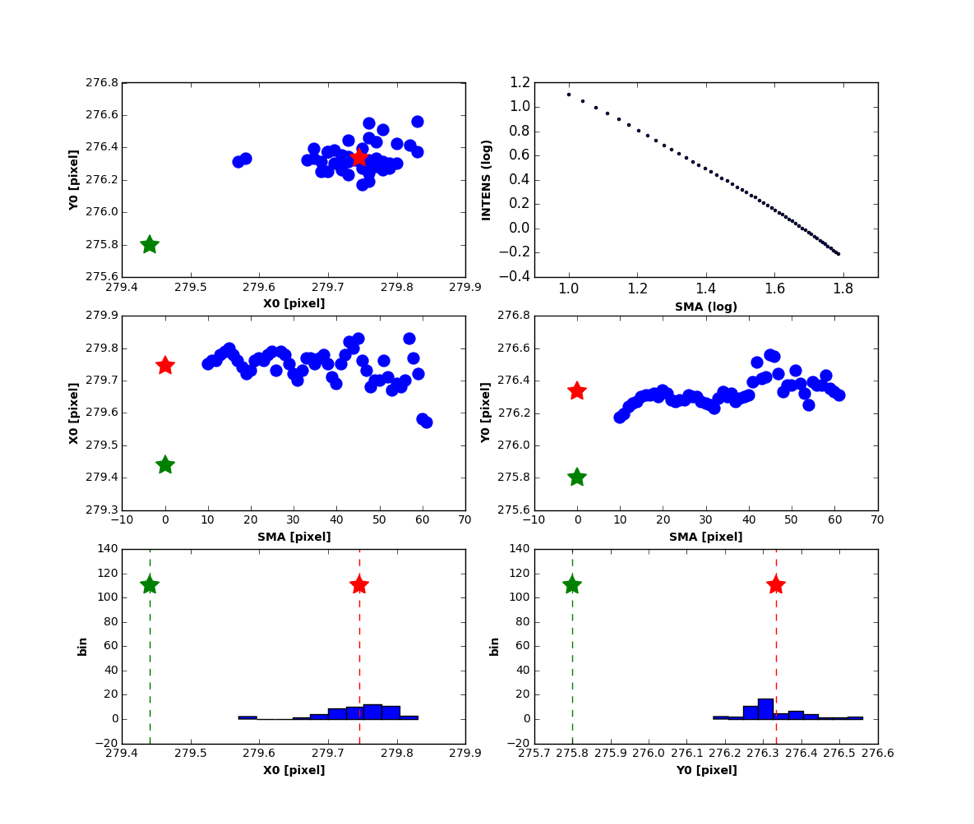
Isophotal analysis of a Hubble Space Telescope image (NICMOS2/F160W) of the radio galaxy 3C076.1. The blue circles show the center co-ordinates of fitted elliptical isophotes in image pixels, the green and red stars show, respectively, the AGN position (tracing the SMBH) and the flux-weighted mean photocenter of the galaxy. The radial displacement between the two is 47 milliarcseconds, corresponding to 29 parsecs (Jadhav 2019, Ph.D. Dissertation, RIT; Jadhav et al. 2019, in preparation.)
Multiwavelength Studies of OH Megamaser Galaxies
Galaxy mergers are believed to play a key role in galaxy evolution and are also thought to trigger the most luminous AGN. Late-stage mergers typically appear as highly luminous infrared sources, since gas driven inwards by the merger triggers powerful starbursts and AGN; the emitted UV/optical light heats the surrounding dust, which radiates in the IR. In some 20% of cases, extremely luminous maser emission in radio frequency lines of the hydroxyl (OH) molecule is also observed. As they are often found in gas-rich mergers, it has been suggested that OH masers constitute an important signpost of dust-obscured star formation. However, dust-embedded AGN also provide suitable conditions for OH maser emission, with the dusty circumnuclear torus providing the molecular gas and also the IR radiation that pumps the maser transitions. We are conducting a multiwavelength study of these OH megamaser galaxies, which includes imaging and spectroscopic observations of a sample of 15 galaxies spanning radio through IR wavelengths. The goal is to determine the place of OHMGs in the evolutionary sequence from gas-rich galaxy merger to emergent quasar by determining if the maser emission is associated with the AGN, or with star formation activity.
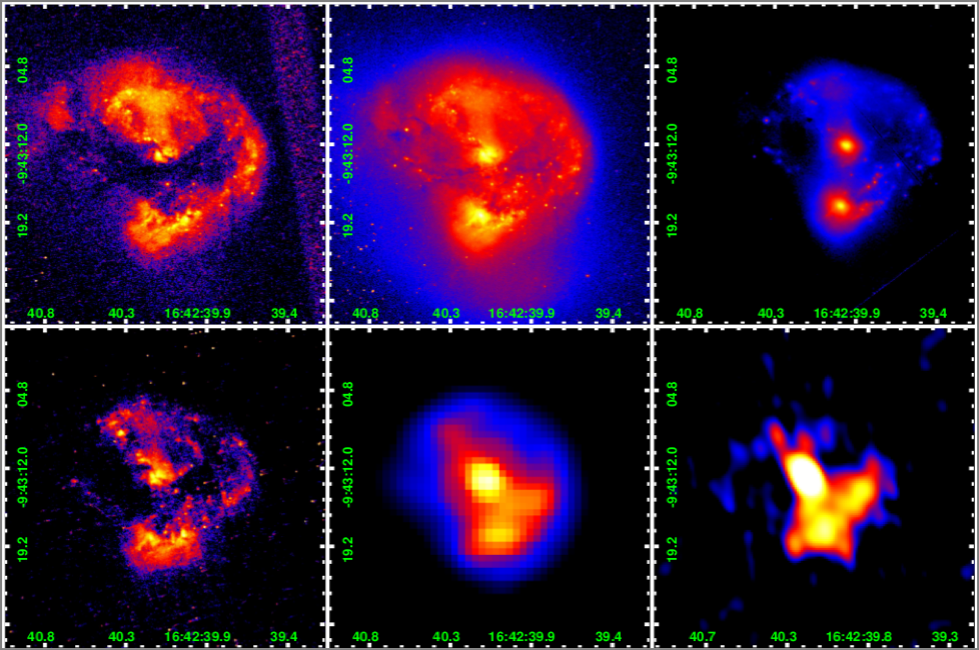
Multiwavelength observations of IRAS16399-0937, an advanced galaxy merger hosting an OH megamaser. Top row, left to right: Hubble Space Telescope images at 0.4, 0.6 and 1.6 µm. Bottow row: HST image of ionized gas emission in Hydrogen (Ha) and Nitrogen ([NII]6548,83); Spitzer IR image at 8 µm and Very Large Array radio image at 1.49 GHz. From Sales et al. 2015, ApJ, 799, 25).
Fueling and Feedback in AGN
Mass inflows in the form of interstellar gas are necessary to feed the SMBH and trigger nuclear activity. However, the exact mechanism by which mass is transferred from galactic down to nuclear scales is long-standing problem that has yet to be resolved. It has been shown theoretically that structures such as galactic bars can efficiently promote gas inflow towards the inner regions, transporting gas down to within ~1 kpc of the AGN. Similarly, dusty spiral arm-like structures occur frequently in the inner kiloparsec of active galaxies, and have been identified as possible fueling channels for the SMBH. Gas outflows are also prevalent amongst more powerful AGN and transfer mechanical energy to the host galaxy’s interstellar medium. We are undertaking a systematic study of a hard X-ray selected sample of 20 low redshift active galaxies spanning a wide range in nuclear activity, using integral field spectroscopy to map the kinematics and excitation conditions of the circumnuclear ionized gas. We are using the data to distinguish the different kinematic components so that non-rotational motions such as inward streaming and/or outflows can be isolated from the large-scale rotational motions. This allows us to identify the ionization sources of the kinematic components and determine the physical parameters of the inflows and outflows such as the gas density, mass and kinetic energy flow rates and geometry.
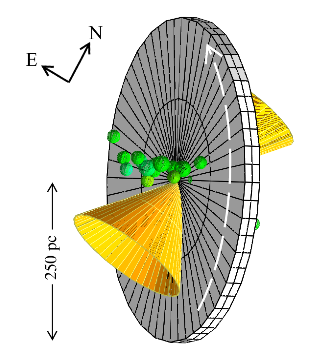
Model for the kinematic and ionization components of circumnuclear ionized gas in the Seyfert galaxy NGC1386, deduced from integral field spectroscopy obtained with the Gemini North Telescope. The components include a rotating disk (grey), a polar outflow within the ionization cone (gold) and an equatorial outflow (green spheres). (Lena et al. 2015, ApJ, 806, 84.)